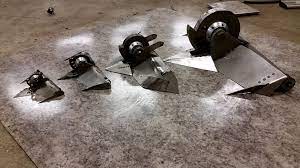Difference between revisions of "RobotClasses"
m (→Weapon Restricted Classes: Example) |
|||
| Line 36: | Line 36: | ||
=Weapon Restricted Classes= | =Weapon Restricted Classes= | ||
| − | These robot classes align with an existing weight class but have further restrictions on what weapons can be used as well as other possible restrictions on things like using ground-scraping wedges | + | These robot classes align with an existing weight class, but have further restrictions on what weapons can be used as well as other possible restrictions on things like using ground-scraping wedges. These classes may be less destructive for builders who don't want their creations so easily destroyed. They are often used for events where they don't have an arena that can safely contain a full-combat robot. For example, spinning weapons may be forbidden, or limited in kinetic energy. |
| + | |||
| + | Before entering this type of competition, please read your event's rules to understand the restrictions. | ||
| + | |||
* 150g (Non-destructive) | * 150g (Non-destructive) | ||
* 12lb (Tabletop) | * 12lb (Tabletop) | ||
Revision as of 09:14, 28 November 2021
Robot Classes
To keep matches fair robots compete against robots that are in a similar "class". This is most commonly defined by the weight allowed for the robot but there are other things like weapon-type or robot-construction that determine classes. If you are thinking of building a robot you should find out what classes are allowed in your local event. Be aware that the weight allowed for "Antweight and Beetleweight" robots differs across events so be sure to know what you are allowed to do before you build your robot. Also be aware that some robot classes are very popular while others are very rare, so before you build a 6lb Mantis weight robot be sure that your local event runs that weight class.
Weight Classes
These weight classes are primarily determined by the maximum weight allowed for the robot. Some rules also have size restrictions so be sure to read the rules for your local event.
| Class | SPARC | FRA | Special |
|---|---|---|---|
| Fleaweight | 75g | -- | -- |
| Fairyweight | 150g | -- | -- |
| Antweight | 1lb | 150g | -- |
| Beetleweight | 3lb | 1.4kg | -- |
| Mantisweight | 6lb | -- | -- |
| Dogeweight | 15lb | -- | National Robotics League |
| Featherweight | 30lb | 30lb | -- |
| Lightweight | 60lb | -- | -- |
| Middleweight | 120lb | -- | -- |
| Heavyweight | 220lb | -- | -- |
| TV-Heavyweight | 250lb | -- | BattleBots |
Often weight bonuses will be offered for specific design features. For example, SPARC rules allow for bots to be up to 50% heavier for bots which shuffle instead of roll, or double weight for bots which fully qualify as Non-Wheeled. Likewise, BattleBots heavyweights can currently be up to 500.0 pounds if they can walk using articulated legs, and meet a number of other design criteria.
Weapon Restricted Classes
These robot classes align with an existing weight class, but have further restrictions on what weapons can be used as well as other possible restrictions on things like using ground-scraping wedges. These classes may be less destructive for builders who don't want their creations so easily destroyed. They are often used for events where they don't have an arena that can safely contain a full-combat robot. For example, spinning weapons may be forbidden, or limited in kinetic energy.
Before entering this type of competition, please read your event's rules to understand the restrictions.
- 150g (Non-destructive)
- 12lb (Tabletop)
- 12lb (Sportsman)
- 30lb (Sportsman)
- 30lb (Tabletop)
- 60lb (Sportsman)
Construction Restricted Classes
In an effort to make robot building more accessible the plastic antweight class was started by Western Allied Robotics. These robots are primarily 3d printed but can be fabricated out of approved plastics. The robot class became popular and the rules were adopted by Sparc.tools.
- 1lb (Plastic_Antweights)
